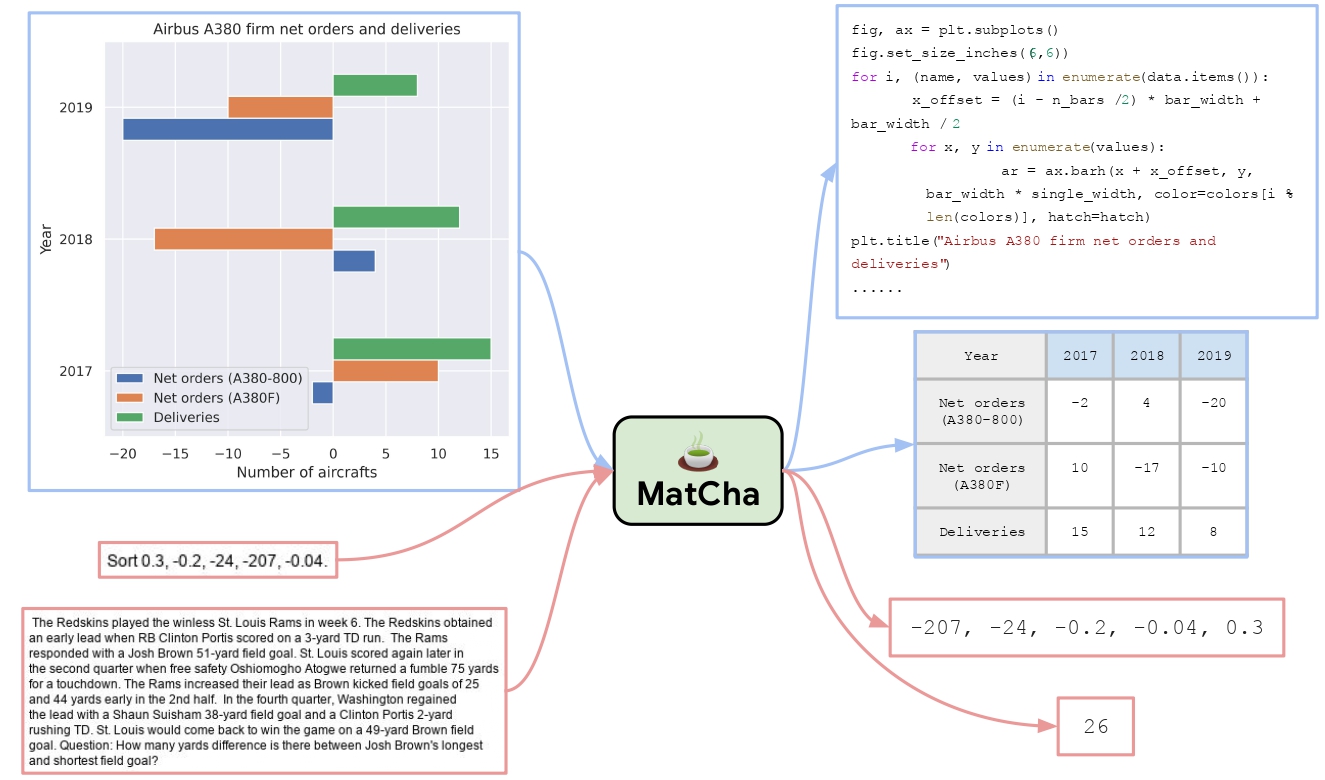🚀 Model card for MatCha - fine-tuned on Chart2text-pew
This is the MatCha model fine-tuned on the Chart2text-pew dataset, which might be better for chart summarization tasks.

🚀 Quick Start
📋 General Information
| Property |
Details |
| Supported Languages |
en, fr, ro, de, multilingual |
| Inference |
false |
| Pipeline Tag |
visual-question-answering |
| License |
apache-2.0 |
| Tags |
matcha |
📚 Table of Contents
- TL;DR
- Using the model
- Contribution
- Citation
✨ Features
The abstract of the paper states that visual language data like plots, charts, and infographics are widespread in the human world, but current state-of-the-art vision - language models don't perform well on such data. The MATCHA (Math reasoning and Chart derendering pretraining) is proposed to enhance visual language models’ capabilities in jointly modeling charts/plots and language data. It includes several pretraining tasks covering plot deconstruction and numerical reasoning, which are key in visual language modeling. Starting from Pix2Struct, MATCHA outperforms state - of - the - art methods by nearly 20% on benchmarks like PlotQA and ChartQA. It also shows overall improvement in domains such as screenshots, textbook diagrams, and document figures, verifying its usefulness in broader visual language tasks.
💻 Usage Examples
🔍 Basic Usage
from transformers import Pix2StructProcessor, Pix2StructForConditionalGeneration
import requests
from PIL import Image
processor = Pix2StructProcessor.from_pretrained('google/matcha-chart2text-pew')
model = Pix2StructForConditionalGeneration.from_pretrained('google/matcha-chart2text-pew')
url = "https://raw.githubusercontent.com/vis-nlp/ChartQA/main/ChartQA%20Dataset/val/png/20294671002019.png"
image = Image.open(requests.get(url, stream=True).raw)
inputs = processor(images=image, return_tensors="pt")
predictions = model.generate(**inputs, max_new_tokens=512)
print(processor.decode(predictions[0], skip_special_tokens=True))
⚙️ Converting from T5x to huggingface
You can use the convert_pix2struct_checkpoint_to_pytorch.py script as follows:
python convert_pix2struct_checkpoint_to_pytorch.py --t5x_checkpoint_path PATH_TO_T5X_CHECKPOINTS --pytorch_dump_path PATH_TO_SAVE --is_vqa
If you are converting a large model, run:
python convert_pix2struct_checkpoint_to_pytorch.py --t5x_checkpoint_path PATH_TO_T5X_CHECKPOINTS --pytorch_dump_path PATH_TO_SAVE --use-large --is_vqa
Once saved, you can push your converted model with the following snippet:
from transformers import Pix2StructForConditionalGeneration, Pix2StructProcessor
model = Pix2StructForConditionalGeneration.from_pretrained(PATH_TO_SAVE)
processor = Pix2StructProcessor.from_pretrained(PATH_TO_SAVE)
model.push_to_hub("USERNAME/MODEL_NAME")
processor.push_to_hub("USERNAME/MODEL_NAME")
🤝 Contribution
This model was originally contributed by Fangyu Liu, Francesco Piccinno et al. and added to the Hugging Face ecosystem by Younes Belkada.
📄 Citation
If you want to cite this work, please consider citing the original paper:
@misc{liu2022matcha,
title={MatCha: Enhancing Visual Language Pretraining with Math Reasoning and Chart Derendering},
author={Fangyu Liu and Francesco Piccinno and Syrine Krichene and Chenxi Pang and Kenton Lee and Mandar Joshi and Yasemin Altun and Nigel Collier and Julian Martin Eisenschlos},
year={2022},
eprint={2212.09662},
archivePrefix={arXiv},
primaryClass={cs.CL}
}

